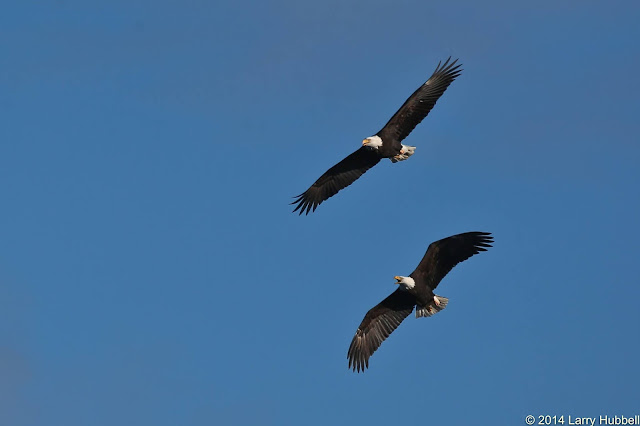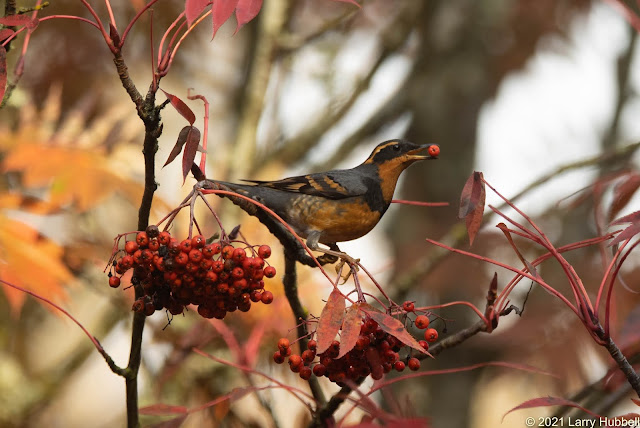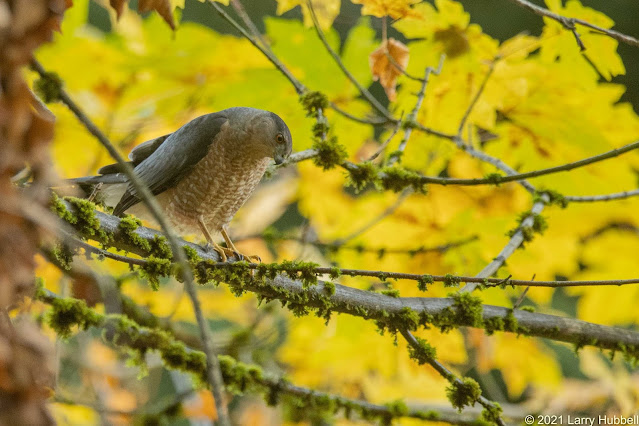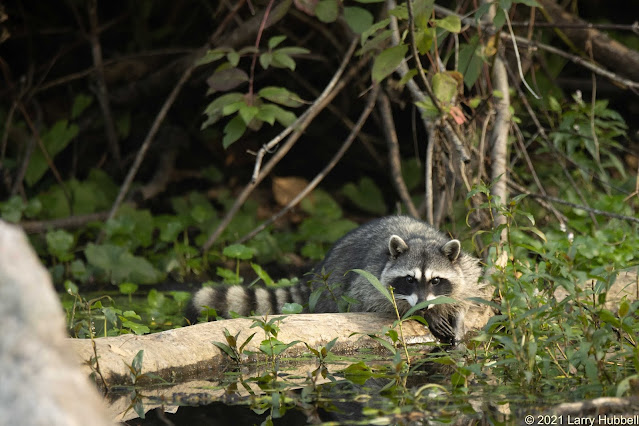On Tuesday, Marsha and Monty sat on the top of this University of Washington Sequoia tree, directly north of their Montlake Cut nest site. The fact that their nest disappeared did not seem to concern them.
Last May the nest was quite substantial. It lasted through the Spring and Summer, while they successfully raised their young.
However last Saturday, my friend Jerry pointed out that the nest was gone. In the last month we have had some windy days. Most likely the remnants of the nest are mixed in among the branches of the tree, and the many wind-blown fallen branches on the ground.
Click Here to read how an earlier than normal Fall wind can be hard on trees.
When the wind blows hard, Bald Eagles can simply spread their wings and gain lift immediately. They may be our only bird species that appears to enjoy a blustery day.
Still, the loss of their of nest is no small thing. The U.S. Fish and Wildlife website says that Bald Eagles' nests are usually 4 to 5 feet in diameter and 2 to 4 feet deep. Over time, since Bald Eagles normally add-on every year, they can become huge - a thousand pounds or more. (Click Here and read the tenth paragraph to be stunned by the largest nest ever.)
Monty and Marsha are not the only Bald Eagles who face challenges around Union Bay.
Talia and Russ, who nest on the north side in the old Talaris property, have construction and development headed their way. Click Here to read more about this situation.
Eva and Albert, who nest to the south in Broadmoor, had no young last Spring for the first time in years. I am hoping this year their previous productivity returns. The next few photos provide a hint of hope for them.
On Wednesday, this young eagle was perched on the Cottonwood tree on the north end of Foster Island. It is a great place for eagles to survey Union Bay while hunting for fish or waterfowl.
Before maturing, establishing a territory and mating, young Bald Eagles tend to roam about looking for food anywhere they can get it. Reaching maturity and gaining a pure white head and tail usually happens in their fourth or fifth year.
After a few minutes, the young eagle looked over its shoulder and lifted its wings. (This particular tree has historically been inside the northern boundary of Eva and Albert's territory.)
The white spots on the wings and body along with dark spots on the head and tail are hints that this bird is not fully mature. The shadowy dark eye stripes make me think it might be around three years old.
Albert, the male from the Broadmoor nest, flew in from the south with a full head of steam. He tucked his wings and dived toward the intruder.
The young bird turned tail and headed north as fast as possible. Here the dark edging on the tail is visible as well as the white spots on the wing.
The last I saw they were almost across the bay and closing in on Laurelhurst. Defending your territory is a critical first step toward having food for your young in the Spring.
Earlier in the month I watched an opposite example. This young eagle was perched in the same tree. At that point in the Fall it may have been difficult for the Broadmoor eagles to monitor the tree because of all the leaves.
The lucky young bird flew east from Foster Island and snagged a fish from Union Bay without Eva or Albert noticing. Still, it is encouraging that they are currently present and defending their territory.
Last Sunday, the day after Jerry mentioned that Marsha and Monty's Montlake Cut nest was gone, I went to check on the situation. When a nest falls I always get the question, will they abandon their territory? I was reassured to find Marsha in the tree sitting directly above the nest site.
I don't know if you noticed in the earlier presentation of this photo, but the few "remaining" branches in the crotch of the tree are actually somewhat fresh. They still had leaves attached. It seems to me, that only Monty and Marsha could have placed fresh branches at this location in their nest tree. This, along with Marsha's presence, was very calming. Besides, this is not their first rebuild.
This is the same nest site in November of 2019 after the previous nest fell.
This is the site in January of 2020...
...and here it is March of 2020 when actual nesting began.
They appear to still be committed to both their territory and their chosen nest site. If you are interested in following their nest-building progress, the nest location is in the first tree south of the totem pole at the southeast corner of Montlake Cut. Both of which are south of the new viewing platform.
In December of 2018, it was possible to see them breaking upper branches off the Cottonwoods on the north side of Montlake Cut and carrying them over to the nest site on the south side. This photo was taken during their first rebuild.
Monty and Marsha came to Union Bay and began building their first nest in 2017. Here are links to a few highlights from all their nesting adventures:
- April 2018 - The First Nest
- July 2018 - Nest Troubles
- August 2018 - Leaving Home
- November 2018 - Freedom
- July 2019 - A Fire Truck Adventure
- July 2020 - A Normal Fledging
- July 2021 - First Flight
Have a good day on Union Bay...where nature lives in the city and Black Birders are welcome!
Larry
Going Native:
Each of us, who breathe the air and drink the local water, needs to watch and protect our local environment. Native plants and trees encourage the largest diversity of lifeforms because of their long intertwined history with our local environment and native creatures. I have been told that even the microbes in the soil are native to each local landscape. I hope we can inspire ourselves, our neighbors, and local businesses to respect native flora and to support native wildlife at every opportunity. I have learned that our most logical approach to native trees and plants (in order of priority) should be to:
1) Learn and leave established native flora undisturbed.2) Remove invasive species and then wait to see if native plants begin to grow without assistance. (When native plants start on their own, then these plants or trees are likely the most appropriate flora for the habitat.)3) Scatter seeds from nearby native plants in a similar habitat.4) If you feel you must add a new plant then select a native plant while considering how the plant fits with the specific habitat and understanding the plant's logical place in the normal succession of native plants.
Click Here to access a King County publication that explains the best placement for a wide variety of native plants. It looks extremely helpful.
Also, my friend Tom Brown pointed out that the application named 'Wildflower Search' is very helpful. Click on the highlighted link to see for yourself.
Also, Jane Lundin has created a small package, with a lot of critical information that looks quite handy, and light, for backpacking in the mountains in Springtime. It is titled, Mountain Wildflowers of Washington.)
Another idea that integrates perfectly with living in harmony with nature is the concept of Forest Gardening. Native Americans collected and nurtured dense multi-layered gardens of native herbs, plants, shrubs, and trees that produced food and herbal medicines. Even after 150 years of no maintenance, the gardens are essentially intact and the diversity of life remains significantly higher than in the surrounding forests. Click Here to learn more.
**************
In the area below it is my intention to display at least one photo each week to help challenge us to know the difference between native and non-native lifeforms.
Scroll down for the answer.
****************
Snowberry - When the berries are present, often long into winter, this plant is easy to identify. However, once the berries have fallen, the leaves can be curiously-shaped (both lobed and not lobed) and not so easy to identify. Even though many birds are not very interested in the fruit, other animals enjoy them.
For those of you who have been noticing my attempts to merge photos this is another example. The first photo focused on the leaf on the left while the second focused on the berries on the right. By merging the two photos I ended up with two separate areas in focus. It is kind of funny how having two different focus points plays with the depth perception.
The tiny missing square in the upper left is a hint that I moved slightly while taking the two photos.
*****************
The Email Challenge:
In response, I have set up my own email list. With each post, I will manually send out an announcement. If you would like to be added to my personal email list please send me an email requesting to be added. Something like:
Larry, I want to see more of nature. Please add me to your personal email list.
Thank you for your patience and interest!
My email address is:
LDHubbell@comcast.net
*******************
A Final Photo:







































































